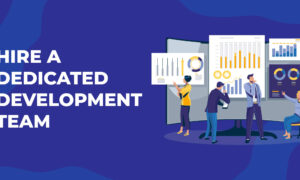Front-end development plays a pivotal role in crafting engaging user experiences that leave a lasting impression on website visitors and application users. It involves the creation and implementation of the user interface (UI) and user experience (UX) elements that users interact with directly. Front-end developers use their expertise in HTML, CSS, and JavaScript to design visually appealing and intuitive interfaces that are both aesthetically pleasing and highly functional.
They strive to ensure seamless navigation, smooth interactions, and responsive design across various devices, creating a user-friendly experience that keeps users engaged and encourages them to explore further. By focusing on optimizing loading times, accessibility, and overall performance, front-end developers enhance the overall usability and satisfaction of the end-users.
Whether it’s a website, a mobile app, or a web application, the art of front-end development empowers businesses to make a positive impact, build brand loyalty, and foster meaningful connections with their audience.
In most cases the technical part of a site or application is associated with a programmer. As for the visual part, it’s connected with a designer. But it’s not everything, and the front-end developer is also a person who is very important part of the whole process of creation. It connects the functionality and code of the site with its visual shell and creates a convenient, correctly working product for the user.
A front-end developer is a specialist who creates user interfaces. He is responsible for the entire external part of the site or application with which people interact: menus, product cards in an online store, buttons, feedback forms. Thanks to the quality work of a front-end developer, fast and convenient sites appear.
What does a frontend developer do

Source: simplilearn.com
Front-End Development Services are seamlessly executed by a skilled team comprising a backend developer and a designer, each contributing their expertise to deliver a cohesive and dynamic user experience.
The backend developer takes charge of constructing the technical framework of the website or application, meticulously designing the internal architecture and devising the mechanisms for efficient data collection, processing, and storage. Their role ensures that the site operates smoothly and securely behind the scenes.
On the other hand, the designer takes on the creative aspect, crafting the site’s layout with an artistic eye. They make critical decisions on color palettes, font styles, iconography, and the arrangement of elements on the screens, all with the aim of optimizing visual appeal and user interaction.
Acting as the bridge between the backend and design aspects, the front-end developer’s core responsibility lies in translating the technical blueprint into the tangible visual form prescribed by the designer.
They expertly weave together HTML, CSS, and JavaScript to transform abstract concepts into an engaging and responsive user interface. By collaborating harmoniously, this cohesive team ensures that the front-end of the website or application seamlessly complements its powerful backend, resulting in a captivating and user-centric digital experience.
To do this, it performs the following tasks:
- Brings the design layout to life: typesets the service, adds text, images, buttons, icons, pop-ups and chats.
- Adjusts the interactivity of pages: so that all buttons lead to the correct pages and internal links work correctly.
- Responsible for how the service looks and works on different devices. You can also thank the front-ender for a beautiful and convenient or “crooked” mobile version of the site.
Hard skills for the developers to be taken into consideration:

Source: vinirshah.com
- Knowing HTML and CSS is the foundation. HTML allows you to create a page structure, and CSS allows you to set styles: how headings, captions, tables, graphics will look like.
- Know JavaScript. This is a language that allows you to make pages interactive and link them together.
- Knowledge of Git version control system as a part of the whole process of creation.
- Master Vue.js and React.js for work.
- Understand the basics of site and service usability, principles of cross-platform layout in order to create user-friendly interfaces.
- It is basic to use Figma or Photoshop, in case you need to quickly redraw something without the help of a designer.
- Know the stages and specifics of web development in order to communicate with the backender in the same language.
At first, it may seem that the frontend only does what brings beauty and tries to make everything on the site look pretty and, most importantly, work as intended. In fact, the developer involved in the client side of the product also writes code, supplements and extends it.
The main tasks include writing scripts, adaptive page layout. Nevertheless, the opinion that the frontend is simpler than the backend should be gradually abandoned. Both directions are interesting and in their own way difficult for those who are just starting their journey in development.
The future prospects of front-end development

Source: linkedin.com
The future prospects of front-end development are incredibly promising, with an ever-increasing emphasis on creating compelling user experiences. As technology continues to advance rapidly, front-end developers will play a critical role in shaping the digital landscape and meeting the evolving demands of users.
With the rising popularity of mobile devices and the Internet of Things (IoT), front-end developers will need to adapt their skills to ensure seamless experiences across various platforms and devices. The incorporation of augmented reality (AR), virtual reality (VR), and voice interfaces will open up new avenues for front-end development, allowing developers to create even more immersive and interactive user experiences.
Furthermore, the growing importance of accessibility and inclusivity in digital products will require front-end developers to design interfaces that cater to diverse user needs.
Conclusion
As data analytics and artificial intelligence become increasingly integrated into user experiences, front-end developers will need to harness these technologies to deliver personalized and predictive interactions. In summary, the future of front-end development is both exciting and challenging, promising a world of endless possibilities for creating captivating and user-centric digital experiences.
Although frontend and backend are different areas, specialists should generally understand how, what and why their colleagues do. The site should be considered as a single project: it is not necessary to thoroughly study the technical side if you are engaged in layout and make a visual, but it is important to be able to evaluate the work of the site as a whole.


















